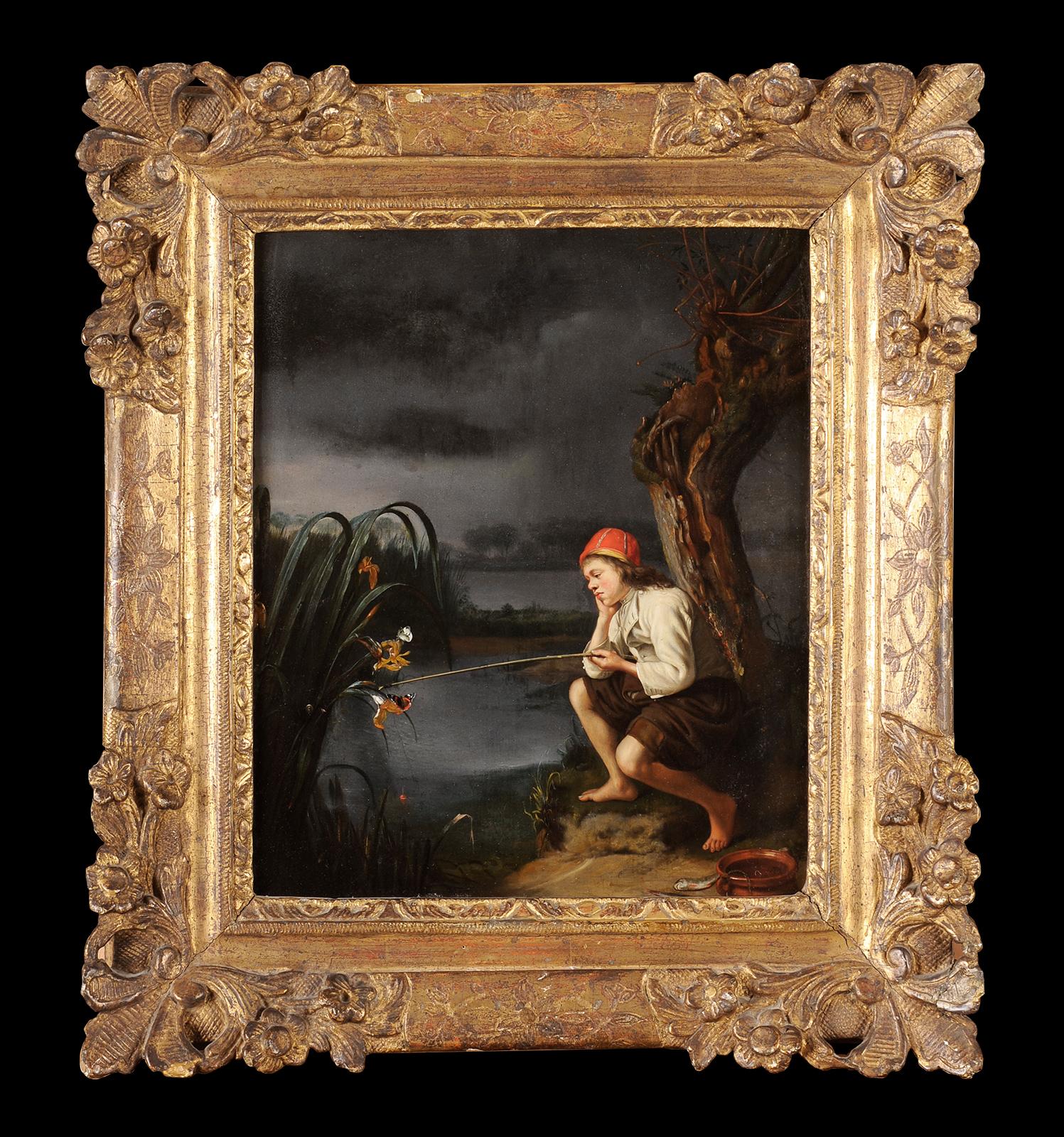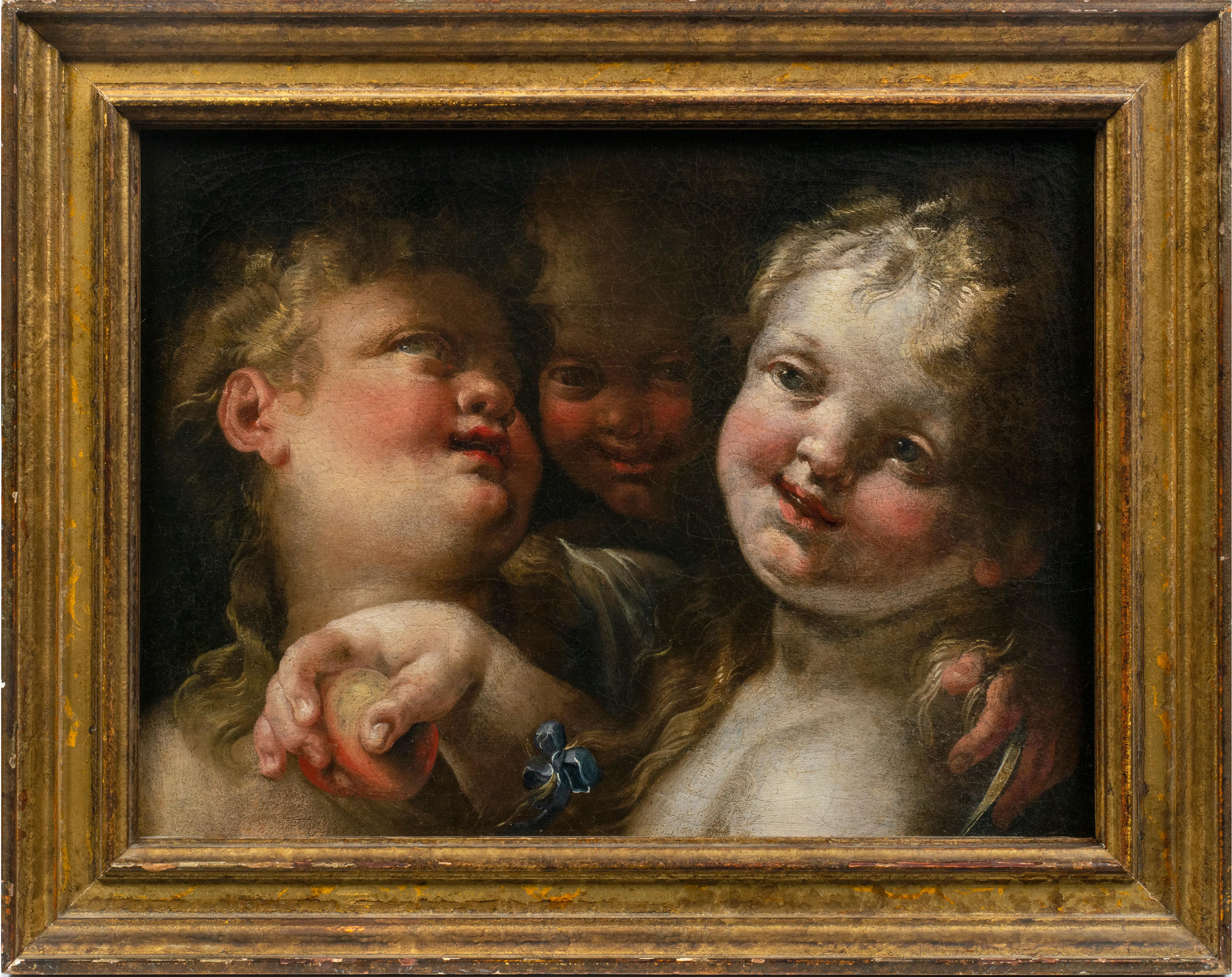Items Similar to INSIDE SCENE- Belgian School - Italian figurative oil on canvas painting
Want more images or videos?
Request additional images or videos from the seller
1 of 15
Eugenio De BlasiINSIDE SCENE- Belgian School - Italian figurative oil on canvas painting2005
2005
About the Item
INSIDE SCENE - Oil on canvas painting, Eugenio De Blasi, Italy, 2005
Gold leaf gilded wooden grame cm. 90X130
The painting by Eugenio De Blasi is inspired by the work of David Teniers, a Belgian painter who represented village festivals and scenes of everyday life, portraying rustic housewife or tavern scenes, The characterization of the characters and the humorous or even grotesque vein strikes the work of David in representing them.
- Creator:
- Creation Year:2005
- Dimensions:Height: 23.63 in (60 cm)Width: 39.38 in (100 cm)
- Medium:
- Movement & Style:
- Period:
- Framing:Frame IncludedFraming Options Available
- Condition:
- Gallery Location:Napoli, IT
- Reference Number:1stDibs: LU568310234912
About the Seller
4.8
Vetted Seller
These experienced sellers undergo a comprehensive evaluation by our team of in-house experts.
1stDibs seller since 2017
146 sales on 1stDibs
Typical response time: 1 to 2 days
- ShippingRetrieving quote...Ships From: Napoli, Italy
- Return PolicyA return for this item may be initiated within 14 days of delivery.
More From This SellerView All
- SPRING BEAUTY - Angelo Granati - Oirtrair of Oil on Canvas PaintingBy Angelo GranatiLocated in Napoli, ITSPRING BEAUTY - Oil on canvas painting by Angelo Granati, Italy 2011 Gold leaf gilded, pleated silk and mirror wooden frame ext. mis. cm. 164x106. This is his reinterpretation of pa...Category
2010s French School Figurative Paintings
MaterialsCanvas, Oil
- LADY'S PORTRAIT - Venetian School - Oil on Canvas Italian Figurative PaintingBy Giovanni SantanielloLocated in Napoli, ITLady's portrait - Giovanni Santaniello Italia 2002 - Oil on canvas cm. 100 x 80 The painting by Giovanni Santaniello depicts a portrait of a beautiful pensive woman in elegant clothe...Category
Early 2000s Italian School Portrait Paintings
MaterialsOil, Canvas
- LADY IN BLACK-In the Manner of G. Bodini Italy figurative oil on canvas paintingBy Eugenio De BlasiLocated in Napoli, ITLADY IN BLACK - Oil on canvas painting, Eugenio De Blasi, Italy, 2011 This is his reinterpretation of a greatest old master painting by Giovanni Boldini. Gold leaf gilded and mohogan...Category
Early 2000s Italian School Figurative Paintings
MaterialsOil, Canvas
- AUTUMN'S ALLEGORY - Eugenio De Blasi - Italian Portrait Italian Oil on CanvasBy Eugenio De BlasiLocated in Napoli, ITAutumn's Allegory - Oil on canvas cm.60x50, Italia, 2007, Eugenio De Blasi (3c59a) The painting by Eugenio De Blasi is an autumn allegory inspired by the allegorical figures of the ...Category
Early 2000s Italian School Portrait Paintings
MaterialsCanvas, Oil
- CHERUBIM WITH FLOWERS- Italian School - Italian Figurative Oil paintingBy Giulio Di SottoLocated in Napoli, ITCherubim with flowers - Oil on canvas cm.80x100 by Giulio Di Sotto, Italy, 2002. Gold leaf gilded wooden frame available on request This wonderful oil on canvas represents two putti...Category
Early 2000s Old Masters Portrait Paintings
MaterialsOil, Canvas
- PORTRAIT OF UGO FOSCOLO - Antonio Jannone - Italian Oil On Canvas PaintingBy ANTONIO JANNONELocated in Napoli, ITPORTRAIT OF UGO FOSCOLO - Oil on canvas cm.50x40, Antonio Jannone, Italy, 2002. this beautiful portrait of the Italian poet Ugo Foscolo is the painter's pe...Category
Early 2000s Old Masters Portrait Paintings
MaterialsOil, Canvas
You May Also Like
- Young fisher - Phlegmatism allegoryLocated in BELEYMAS, FRAttributed to Godfried SCHALKEN (Made 1643 – The Hague 1706) Young fischer Oil on panel in one board H. 32.5 cm; L. 25.5 cm Around 1670/75 Related works: - Autograph version with numerous variants, Berlin, Gemaldegalerie, Inv. N°837 - Copy or workshop version of our painting with slight variations but of inferior quality, Germany, sold at Berlinghof Auktionshaus in 2002 The object of this notice is not to produce a biography of Schalken, the reference work by Thierry Beherman published by Maeght in 1988. The goal here is to understand this version of a painting of formidable craftsmanship and to compare it to the work preserved in Berlin with its many variants in order to draw some hypotheses for conclusions Our young angler is a very interesting subject that can be found as early as the 16th century to invoke one of the four temperaments. Not melancholy as one might think at first glance, but phlegmatic character. The interpretation of astrological symbols closely linked peach and phlegm, laziness, slowness, often represented alongside the moon. Here the composition is very clear in this sense. The young man, chin resting on his arm, looks at his modest cane, the cork of which he soaks alongside snails and butterflies located in the Irises. All near a willow under a heavy sky, like a night sky. All the elements are there to give an explanation of the subject and not to leave the spectator in front of a simple genre scene. Let's go back to the willow, a tree that loses its fruits before they mature. It is often considered a symbol of lost youth, a reference to passivity or times of debauchery. Plato advised in his time to banish fishing from the education of children since it is an activity of expectation and not of exercise or reflection. Needless to explain the presence of small slow-moving animals with short lives or flowers… The image speaks for itself! Let's go back to the differences between the Berlin version and ours, of which it must be recognized that the quality is slightly lower and therefore can hardly be given with certainty to Schalken itself. This version has some additional elements compared to ours. In our version, the row of willows cut into trunks located to the left of the composition is replaced by a simple area of reeds that opens up to a luminous sky. The sky is also different by the clouds represented. A white butterfly flying in the middle of the Irises has been removed, as has a large leaf located on the back of the young fisherman at the foot of the willow. Only addition to our table in addition to the Berlin version: a second fish near the earthen pot...Category
1680s Flemish School Figurative Paintings
MaterialsOil, Wood Panel
- After Franken School Crucifixion of Jesus PannelLocated in Pasadena, CAFrans Francken the Younger (1581, Antwerp – 6 May 1642, Antwerp was a Flemish painter and the best-known and most prolific member of the large Francken family of artists.[1] He painted large altarpieces for churches as well as smaller historical, mythological and allegorical scenes. His depictions of collectors' cabinets established a popular new genre of art in the era. Francken often collaborated with other artists, adding figures and narrative elements to scenes created by specialists in landscape, architectural and floral still life painting Francken was a versatile artist who practiced in many genres and introduced new subjects into Flemish art. Many of his works are small historical, allegorical and biblical...Category
17th Century Flemish School Figurative Paintings
MaterialsOil
- Head of an AngelLocated in New York, NYProcaccini was born in Bologna, but his family moved to Milan when the artist was eleven years old. His artistic education was evidently familial— from his father Ercole and his elder brothers Camillo and Carlo Antonio, all painters—but his career began as a sculptor, and at an early age: his first known commission, a sculpted saint for the Duomo of Milan, came when he was only seventeen years old. Procaccini’s earliest documented painting, the Pietà for the Church of Santa Maria presso San Celso in Milan, was completed by 1604. By this time the artist had made the trip to Parma recorded by his biographers, where he studied Correggio, Mazzola Bedoli, and especially Parmigianino; reflections of their work are apparent throughout Procaccini's career. As Dr. Hugh Brigstocke has recently indicated, the present oil sketch is preparatory for the figure of the angel seen between the heads of the Virgin and St. Charles Borrommeo in Procaccini's altarpiece in the Church of Santa Afra in Brescia (ill. in Il Seicento Lombardo; Catalogo dei dipinti e delle sculture, exh. cat. Milan 1973, no. 98, pl. 113). As such it is the only known oil sketch of Procaccini's that can be directly connected with an extant altarpiece. The finished canvas, The Virgin and Child with Saints Charles Borrommeo and Latino with Angels, remains in the church for which it was painted; it is one of the most significant works of Procaccini's maturity and is generally dated after the artist's trip to Genoa in 1618. The Head of an Angel is an immediate study, no doubt taken from life, but one stylistically suffused with strong echoes of Correggio and Leonardo. Luigi Lanzi, writing of the completed altarpiece in 1796, specifically commented on Procaccini's indebtedness to Correggio (as well as the expressions of the angels) here: “Di Giulio Cesare...Category
17th Century Old Masters Figurative Paintings
MaterialsCanvas, Paper, Oil
- Three AngelsBy Domenico Piola the ElderLocated in New York, NYProvenance: Robert L. and Bertina Suida Manning, New York, until 1996 Private Collection, USA One of the leading artists in Genoa during the second half of the seventeenth century, Domenico Piola came from a successful family of artists, renowned for their many illusionistic ceiling programs throughout Genoese churches and palaces. A prolific draughtsman and painter, Domenico oversaw an extremely productive studio. In addition to his collaborations with numerous other artists, Domenico also provided many designs for book illustrations and prints that circulated throughout Europe, earning him international exposure and high acclaim in his own day. As Dr. Anna Orlando has indicated (written communication), the present work is an early work by Piola, datable from the late 1640s. At this time the young artist came strongly under the influence of Castiglione and Valerio Castello, while admiring the works of Giulio Cesare Procaccini. Piola’s works from this period are exuberant and fluid, and the artist’s love of portraying children is evident from the angels and putti that populate both his altarpieces and more intimate paintings. The present work depicts three angels...Category
17th Century Baroque Figurative Paintings
MaterialsCanvas, Oil
- The Crimson & Black Kimono, Oil painting by British Artist Jamel AkibBy Jamel AkibLocated in Battle, East SussexJamel Akib Born in Leigh-on-sea, Essex in 1965 to English and Malaysian parents, Jamel moved to North Borneo at the age of five. At thirteen he returned to England to pursue his edu...Category
21st Century and Contemporary Contemporary Figurative Paintings
MaterialsCanvas, Oil
- Conversation with a black capped chickadee No. 1, by British Artist Jamel AkibBy Jamel AkibLocated in Battle, East SussexJamel Akib Born in Leigh-on-sea, Essex in 1965 to English and Malaysian parents, Jamel moved to North Borneo at the age of five. At thirteen he returned to England to pursue his edu...Category
21st Century and Contemporary Contemporary Figurative Paintings
MaterialsCanvas, Oil
Recently Viewed
View AllMore Ways To Browse
Inside Painted
Belgium Art Work
Belgium Paintings
Paintings Of Belgium
Inside Painting
Paintings Italian Scenes
Paintings Scenes Of Italy
Italian Figurative Oil Painting
Belgian Oil
Belgium Oil
Oil Paintings Italian Scene
Oil Painting Belgium
Belgian Oil Painting
Belgian Painter
Belgian Painters
Belgian School
Italian Festival
Grotesque Art


